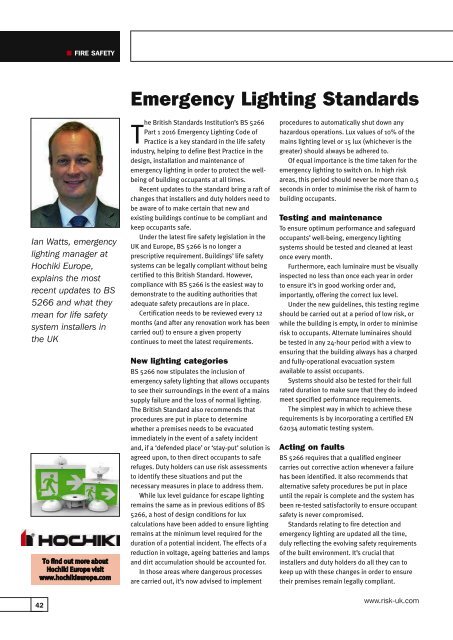PSISeptember2017a
You also want an ePaper? Increase the reach of your titles
YUMPU automatically turns print PDFs into web optimized ePapers that Google loves.
FIRE SAFETY<br />
Emergency Lighting Standards<br />
Ian Watts, emergency<br />
lighting manager at<br />
Hochiki Europe,<br />
explains the most<br />
recent updates to BS<br />
5266 and what they<br />
mean for life safety<br />
system installers in<br />
the UK<br />
To find out more about<br />
Hochiki Europe visit<br />
www.hochikieurope.com<br />
42<br />
he British Standards Institution’s BS 5266<br />
TPart 1 2016 Emergency Lighting Code of<br />
Practice is a key standard in the life safety<br />
industry, helping to define Best Practice in the<br />
design, installation and maintenance of<br />
emergency lighting in order to protect the wellbeing<br />
of building occupants at all times.<br />
Recent updates to the standard bring a raft of<br />
changes that installers and duty holders need to<br />
be aware of to make certain that new and<br />
existing buildings continue to be compliant and<br />
keep occupants safe.<br />
Under the latest fire safety legislation in the<br />
UK and Europe, BS 5266 is no longer a<br />
prescriptive requirement. Buildings’ life safety<br />
systems can be legally compliant without being<br />
certified to this British Standard. However,<br />
compliance with BS 5266 is the easiest way to<br />
demonstrate to the auditing authorities that<br />
adequate safety precautions are in place.<br />
Certification needs to be reviewed every 12<br />
months (and after any renovation work has been<br />
carried out) to ensure a given property<br />
continues to meet the latest requirements.<br />
New lighting categories<br />
BS 5266 now stipulates the inclusion of<br />
emergency safety lighting that allows occupants<br />
to see their surroundings in the event of a mains<br />
supply failure and the loss of normal lighting.<br />
The British Standard also recommends that<br />
procedures are put in place to determine<br />
whether a premises needs to be evacuated<br />
immediately in the event of a safety incident<br />
and, if a ‘defended place’ or ‘stay-put’ solution is<br />
agreed upon, to then direct occupants to safe<br />
refuges. Duty holders can use risk assessments<br />
to identify these situations and put the<br />
necessary measures in place to address them.<br />
While lux level guidance for escape lighting<br />
remains the same as in previous editions of BS<br />
5266, a host of design conditions for lux<br />
calculations have been added to ensure lighting<br />
remains at the minimum level required for the<br />
duration of a potential incident. The effects of a<br />
reduction in voltage, ageing batteries and lamps<br />
and dirt accumulation should be accounted for.<br />
In those areas where dangerous processes<br />
are carried out, it’s now advised to implement<br />
procedures to automatically shut down any<br />
hazardous operations. Lux values of 10% of the<br />
mains lighting level or 15 lux (whichever is the<br />
greater) should always be adhered to.<br />
Of equal importance is the time taken for the<br />
emergency lighting to switch on. In high risk<br />
areas, this period should never be more than 0.5<br />
seconds in order to minimise the risk of harm to<br />
building occupants.<br />
Testing and maintenance<br />
To ensure optimum performance and safeguard<br />
occupants’ well-being, emergency lighting<br />
systems should be tested and cleaned at least<br />
once every month.<br />
Furthermore, each luminaire must be visually<br />
inspected no less than once each year in order<br />
to ensure it’s in good working order and,<br />
importantly, offering the correct lux level.<br />
Under the new guidelines, this testing regime<br />
should be carried out at a period of low risk, or<br />
while the building is empty, in order to minimise<br />
risk to occupants. Alternate luminaires should<br />
be tested in any 24-hour period with a view to<br />
ensuring that the building always has a charged<br />
and fully-operational evacuation system<br />
available to assist occupants.<br />
Systems should also be tested for their full<br />
rated duration to make sure that they do indeed<br />
meet specified performance requirements.<br />
The simplest way in which to achieve these<br />
requirements is by incorporating a certified EN<br />
62034 automatic testing system.<br />
Acting on faults<br />
BS 5266 requires that a qualified engineer<br />
carries out corrective action whenever a failure<br />
has been identified. It also recommends that<br />
alternative safety procedures be put in place<br />
until the repair is complete and the system has<br />
been re-tested satisfactorily to ensure occupant<br />
safety is never compromised.<br />
Standards relating to fire detection and<br />
emergency lighting are updated all the time,<br />
duly reflecting the evolving safety requirements<br />
of the built environment. It’s crucial that<br />
installers and duty holders do all they can to<br />
keep up with these changes in order to ensure<br />
their premises remain legally compliant.<br />
www.risk-uk.com

















